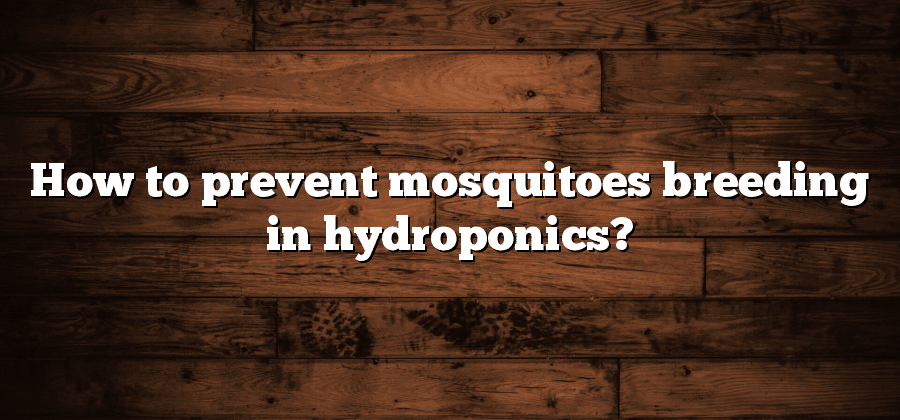Understanding the Mosquito Life Cycle
Mosquitoes, those tiny insects that can cause big problems, have a fascinating life cycle that involves four distinct stages. Understanding this life cycle is essential in effectively managing and controlling these pesky creatures.
The first stage of the mosquito life cycle is the egg. Female mosquitoes lay their eggs in stagnant water or moist areas, allowing them to hatch and begin their transformation into adult mosquitoes. These eggs are incredibly small, almost invisible to the naked eye, making it difficult to identify potential breeding sites. Consequently, it is crucial to be aware of possible areas where stagnant water can accumulate, such as flowerpots, gutters, or even discarded containers, to effectively prevent egg hatching.
Following the egg stage, the mosquito larvae emerge. These larvae appear as wriggling, elongated creatures, often found near the water’s surface. They utilize various strategies to feed on microorganisms present in the water, helping them grow and develop. During this stage, the larvae undergo several molts, shedding their skin as they grow larger. This growth is crucial for their next phase, the pupa stage. In the pupal stage, the mosquito larvae undergo a dramatic transformation, resembling comma-shaped organisms. They do not feed during this stage and instead focus on completing their metamorphosis into adult mosquitoes.
Understanding the intricacies of the mosquito life cycle is pivotal in implementing effective control measures. By identifying and eliminating potential breeding sites, we can interrupt this cycle and significantly reduce the mosquito population. With further comprehension of each stage, we can delve into specific strategies for mosquito control, ultimately creating a more tranquil environment free from these buzzing annoyances.
Identifying Potential Breeding Sites in Hydroponics
Hydroponics is a highly efficient method of cultivating plants without soil, but it also presents unique challenges when it comes to mosquito breeding. Identifying potential breeding sites in hydroponics is crucial to prevent the infestation and proliferation of these disease-carrying pests. It is essential to minimize stagnant water and create an environment that mosquitoes find inhospitable for reproduction.
First and foremost, it is important to regularly inspect the hydroponic system for any stagnant water. Mosquitoes require standing water to lay their eggs, so eliminating these breeding sites is fundamental. Pay close attention to areas where water might accumulate, such as trays, gutters, or channels. These areas should be thoroughly cleaned and dried to prevent mosquitoes from finding a suitable environment to breed. Additionally, it is recommended to regularly empty and clean any reservoirs or reservoir tanks to ensure there is no residual water that could serve as a breeding ground. By proactively inspecting and addressing these potential breeding sites, hydroponic growers can significantly reduce the risk of mosquito infestations and the subsequent spread of diseases.
Implementing Effective Drainage Systems
Effective drainage systems are an essential component of any hydroponics setup. Without proper drainage, excess water can accumulate, leading to root rot and other moisture-related issues. To address this, growers must implement drainage systems that facilitate the rapid removal of excess water while maintaining an optimal growing environment for the plants.
One approach to effective drainage is the use of sloped surfaces or elevated platforms for placing the hydroponic containers. This allows any excess water to flow away from the plants and towards a designated drainage point. Additionally, incorporating drain trays or catchment systems beneath the containers can help collect and redirect the excess water, preventing it from pooling. By ensuring a well-designed drainage system, growers can minimize waterlogging and provide their plants with the necessary oxygen and nutrients for healthy growth.
Evaluating and Adjusting Water pH Levels
Maintaining the appropriate pH levels in water is crucial for the success of any hydroponic system. The pH level indicates the acidity or alkalinity of the water, and it directly affects the nutrient availability to the plants. Evaluating and adjusting water pH levels regularly can significantly impact the overall growth and development of plants in a hydroponic setup.
To begin with, it is essential to have a reliable pH testing kit on hand. These kits are readily available, and they provide accurate readings of the water’s pH level. To evaluate the pH, take a sample of the water from your hydroponic system and follow the instructions provided with the testing kit. The resulting numerical value will indicate whether the water is acidic, alkaline, or neutral. If the pH falls outside the desired range for optimal plant growth, adjustment is necessary.
Adjusting the water pH can be done by using pH modifiers such as pH-up or pH-down solutions. These solutions are specifically designed to raise or lower the pH levels, respectively. It is crucial to follow the manufacturer’s instructions and add the solution gradually to avoid sudden or drastic changes in pH. After adding the solution, retest the water to ensure the desired pH level has been attained. Regularly monitoring and adjusting the pH in your hydroponic system will help create an optimal environment for plant growth and maximize overall productivity.
Utilizing Biological Control Methods
Biological control methods offer a natural and sustainable approach to managing mosquito populations. By harnessing the power of biological agents, such as predatory insects or bacteria, we can effectively control these disease-carrying pests while minimizing the use of harmful chemicals.
One commonly used technique is the introduction of mosquito-eating fish, such as Gambusia affinis, into water bodies that serve as breeding sites. These tiny fish have a voracious appetite for mosquito larvae, quickly reducing their numbers. Another approach involves releasing bacteria called Bacillus thuringiensis israelensis (Bti) into stagnant water sources. Bti produces toxins that only affect mosquito larvae, offering a targeted and environmentally friendly solution. Embracing these biological control methods not only helps in reducing the mosquito population but also maintains the ecological balance and promotes a safer environment for humans and other organisms.






